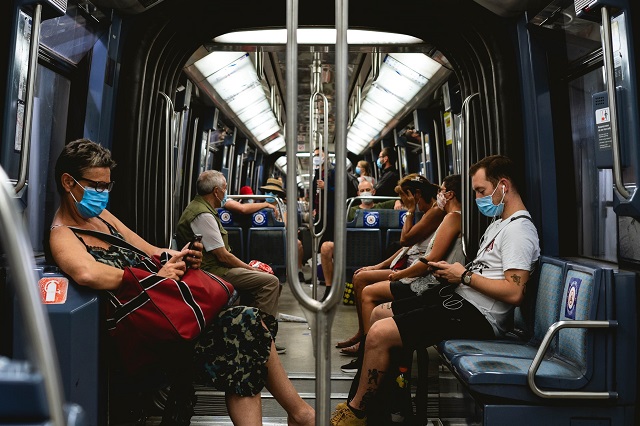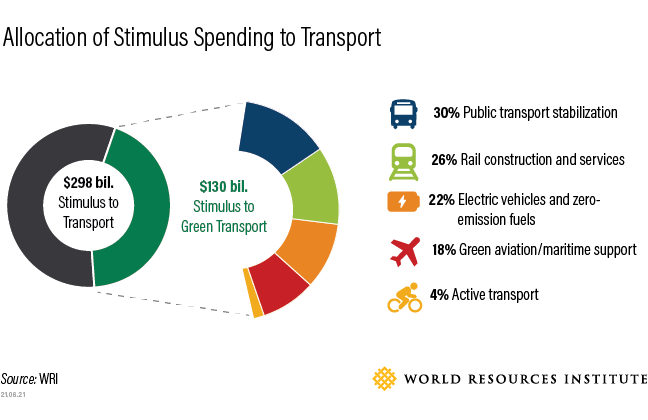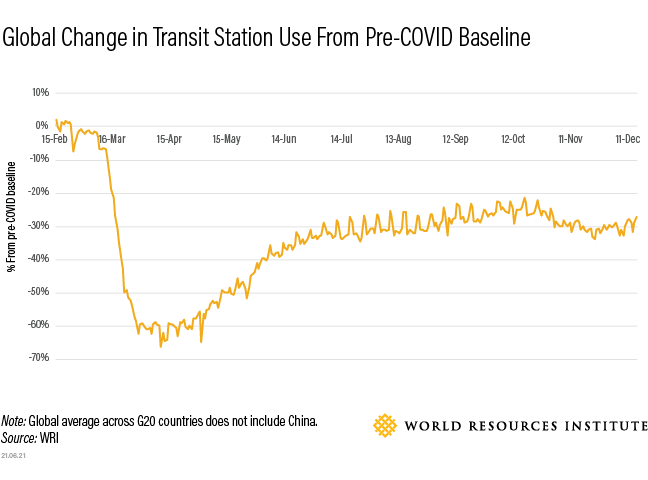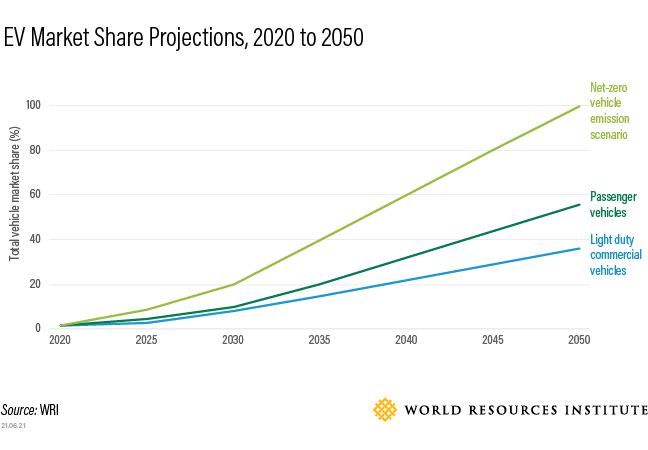
The global coronavirus pandemic brought a wave of public and private initiatives to help societies adapt and recover, from economic stabilization and safety measures to new business models and shifts in consumption. Many of these initiatives are not green, despite the fact that society needs major changes to avoid the most dangerous effects of climate change and ensure health and equity for all.
Transport is a key sector in need of big changes, comprising 14% of global greenhouse gas emissions and 24% of carbon emissions. Meanwhile, over a million traffic fatalities occur every year, millions are exposed to deadly air pollution on roads and the majority of residents in many cities — often the poorest — cannot reach a job within an hour of travel time.
In a new paper with the Transport Decarbonisation Alliance, WRI evaluated countries’, cities’ and companies’ actions during the pandemic that impact the transport sector. We found that of the $298 billion in global recovery funds catalogued by the Energy Policy Tracker in the transport sector between March 2020 and February 2021, only 44% positively affect the climate and sustainability.

Meanwhile, some of the most encouraging actions come from the local level. Hundreds of cities — including Lima, Paris and Addis Ababa — are adding new bicycle and walking facilities as pandemic safety measures. Since March 2020, over 200 cities launched more than 400 bicycle and pedestrian interventions.
Companies stepped up commitments, as well. Corporate alliances, such as the Corporate Electric Vehicle Alliance, saw major international retail, e-commerce, logistics and ride-hail companies publicize plans to decarbonize their vehicle fleets. Major automotive manufacturers also pledged to phase out internal combustion engine vehicles. Between October 2020 and February 2021, business members of the EV100 initiative deployed 89% and 23% more passenger and commercial vehicles, respectively, and installed 79% more charging stations compared to the year prior.
But as countries, cities and companies continue to shift their strategies to longer-term recovery from short-term stabilization, there is significant work to be done to get the world on track for a resilient, net-zero future. We identify five key opportunities for transport investments that can not only address climate change, but create jobs, promote economic development, improve health and bolster equal access to opportunities.
1. Stabilize and Reimagine Public Transport
Public transport ridership and revenues collapsed globally during the pandemic, forcing many agencies to cut services and raise fares. As a result, green stimulus without public transport support is a non-starter.

Per dollar invested, public transport creates more than three times as many jobs as building new highways. Investing in public transport improves equal access to jobs and services, road safety, smart urban growth and limits carbon emissions. Stabilization funds are the first step, as they will help public transport continue to run and employ people. Thirty percent of recovery funds have gone to these funds, including over $20 billion in the United States. Nigeria also committed over $200 million to compensate minibus operators for lost revenues.
The next step is putting public transport on the right track to not just revive, but thrive.
Many locales have a withstanding need to reimagine public transport as the backbone of urban mobility, grounded in reliable funding, better governance and focus on access to jobs, education and services. Instead of building new urban highways, cities can increase national and provincial funding for rapid transit lines and public transport operating costs. Cities can also institute broader mobility policies that manage demand, such as London’s congestion charge, which generated almost $303 million in gross revenue last year. Such measures not only raise revenue for public transport, but put a price on private vehicle traffic.
Planners have a role to play, as well. They can reallocate urban space for bus priority infrastructure, like red carpet lanes, and make systems more user-friendly through digitalization. Delhi introduced mobile payment options on 650 buses and issued over 200,000 tickets in a matter of three months of its initial pilot in the last year.
2. Double-down on Active Transport
Bike lanes and sidewalks have been a critical lifeline during lockdowns, offering fresh air and routes to essential services and jobs. They also create jobs, enliven local retail and promote healthier, safer, emissions-free transport.
Cities that widened sidewalks and popped-up bike lanes during the pandemic should make them permanent. Bogotá, Colombia, which created 84 km of emergency bicycle lanes, announced a plan to add an additional 280 km to their existing 550 km network within four years. The mayor, an avid cyclist herself, wants half of all trips made by bike.
More can be done at the national level, as well. Only 4% of recovery spending shown by Energy Policy Tracker went toward active mobility. This funding is clustered in a few countries like the Netherlands, France and the United Kingdom. National funding for active mobility is low as well, especially in low- and middle-income countries. Green recovery programs should pivot to increased national commitments in bicycling, walking and road safety.
3. Electrify Vehicles
Electric vehicles (EVs) are crucial to decarbonizing transport. Recessions from COVID-19 brought EV sales down 18% for 2020. While sales may rebound, electrification must happen much faster to reach net-zero vehicle emissions by 2050.

Government EV incentives and zero-emission mandates can speed up electrification. The International Council on Clean Transportation found governments that instituted the highest fiscal incentives immediately following the 2008 Great Recession — including the governments of Norway, California and The Netherlands — achieved the largest increases in EV market shares in the years that followed, though some programs had a blind eye to middle and low-income consumers. China achieved almost half the world’s EV market share by mandating zero-emission vehicle manufacturing and subsidizing EV purchases.
Companies also have an essential role to create a loop between mandates and private sector action. Many have announced exit dates from the internal combustion engine market.
This electric renaissance will also require many more public charging stations. Laying out the infrastructure will be a massive public works undertaking, which the International Energy Agency estimates will create 12 jobs per $1 million invested. To put that in perspective, the United States alone will need $4.7 billion in charging infrastructure investment to meet demand over the next five years, resulting over 56,000 jobs.
Private passenger vehicles should not be the only focus. Electric buses can improve equitable access to opportunity for more people and reduce long-term operating expenditures. Santiago, Chile, has the largest electric bus fleet outside China. This fleet has almost 800 electric buses, including 150 ordered this year. One local bus company found operational and maintenance costs were 70% and 37% cheaper, respectively, than with former diesel buses.
4. Shift People and Goods to Rail
In many ways, rail investment is the elephant in the room. During the Great Recession, 26% of global green stimulus funds went to rail, making it the largest category of green stimulus investments across sectors. To date, stimulus spending after COVID-19 has not been so different: Energy Policy Tracker identified almost $30 billion going to rail expansion.
Whether from the public or private sector, recovery investments in rail should be green with mode shift and efficiency in mind. Countries collectively commissioned or planned over 32,000 km of inter-city, high-speed rail, including first-ever high-speed rail connections in countries like India. High-speed rail is 12 times more energy efficient per passenger-kilometer than airplanes and cars. Germany’s Deutsh-Bahn rail corporation announced plans to pilot zero-emission, hydrogen-powered trains by 2024.
Meanwhile, cities in China and India are shifting goods from truck beds to boxcars, saving on emissions and improving local air quality. Investments also should avoid laying track for what could be larger carbon-intensive activities, such as shuttling coal, as was the case in China after the Great Recession.
5. Clean R&D for Harder-to-Abate Sectors
Economic recovery stimulus packages can help mitigate emissions in so-called “harder-to-abate” sectors that require innovative zero-emission fuels and technologies. Clean research and development (R&D) can accelerate the market readiness of zero-emission fuels and lower future price barriers. Hundreds of top bank officials, economists and finance ministers voted clean R&D a class favorite among other stimulus investments for having the highest long-term climate impact.
For example, the aviation sector saw travel plunge 60% since March. A swift return to business as usual could cause aviation to consume up to 27% of the global carbon budget in a 1.5 degree C by 2050 scenario. In the same timeframe, converting conventional aviation fuel to biorenewable fuel could reduce emissions from international flights by 63%. Meanwhile, emerging fuels like hydrogen could eliminate airplane emissions completely. To nudge the transition along, France invested €1.5 billion ($1.8 billion) to support R&D to launch a clean fuel airplane by 2035.
Making Sustainable Mobility Part of the “New Normal”
The world faced enormous changes in the last year and a half and continues to face an unprecedented reality. The transition toward a “new normal” leaves open questions about how to reach a better equilibrium for the environment and people. As countries prepare plans to raise their climate ambitions ahead of COP26, choices in how to spend trillions in stimulus money will have long-lasting effects. Climate change should be central to those choices, and by extent, transport must play a starring role.
Enacting these five recommendations together will create a plethora of benefits, including job creation, road safety, improved air quality, revitalized economies and so much more. Putting equitable and zero-emission mobility front-and-center improves the chances of handing off a better world to today’s young people and future generations.
This article was originally published on WRI’s Insights.
Ben Welle is Acting Director of Urban Mobility and Director of Integrated Transport & Innovation at WRI Ross Center for Sustainable Cities.








